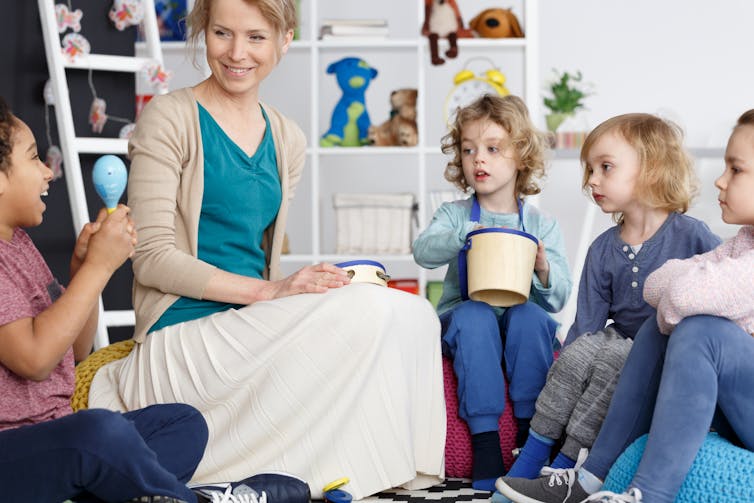Labor's childcare plan may get more women into work. Now what about quality and educators' pay?
- Written by Kate Noble, Education Policy Fellow, Mitchell Institute, Victoria University
Childcare was the centrepiece of last night’s budget reply speech from Leader of the Opposition Anthony Albanese.
He announced Labor’s plan to increase the maximum childcare subsidy from 85% to 90% and remove the annual cap on subsidies for families earning more than A$189,390 per year. This means families earning up to $80,001 would have their subsidy increased by 5% and most families earning more would have their subsidy increased slightly.
Removing the cap would benefit families on middle and high incomes. It currently limits childcare subsidy payments to $10,560 per child per year, for families with a combined income between $189,390 and $353,680.
When the cap is reached for each child, but the family still needs to use childcare, they now pay 100% of the childcare fees in excess of the cap. This acts as a big deterrent to increased parental workforce participation.
For families where both parents work full time, or almost full time, Labor’s proposed measure would result in thousands of dollars saved per year. For parents needing or wanting to work more, and increase their childcare hours, Labor’s plan could make this affordable.
The biggest news is the 90% universal subsidy
The biggest news in Labor’s plan is a longer-term shift to a 90% subsidy for all Australian families. Currently, families with a combined income between $174,390 and $253,680 receive a 50% subsidy. Families earning between $253,680 and $343,680 are subsidised between 20% and 50%.
These families would experience a significant reduction in fees, with exact amounts depending on the amount of childcare they use.
While Labor’s plan comes with a $6.2 billion price tag over four years, the McKell Institute estimates the subsidy boost would deliver a return on investment of at least 100%. This means all the money invested in the childcare measures would return into the economy via increased workforce participation and family spending.
Earlier Grattan Institute analysis also estimated high return on investment from increases to childcare subsidies that get more families working.
If Labor win the next election, the scheme could be in place by as early as July 2022. This is major economic reform that could dramatically increase affordability of childcare in Australia.
What’s missing from Labor’s announcement?
The success of Labor’s plan hinges on making sure increased subsidies flow through to reduced costs for families. In the past, fee increases have offset the benefits of subsidy increases for many families. To prevent this, Labor plans to task the Australian Competition and Consumer Commission with designing a mechanism to effectively regulate service prices.
The plan is also focused on affordability over quality. The benefits for children from early childhood education and care depend on services being good quality, and providing play-based learning programs led by skilled educators. Close to one in five early childhood services still do not meet quality standards, and vulnerable communities are more likely to be served by lower quality services. This means children who should benefit most from quality early learning are more likely to miss out.
Read more: Preschool benefits children and the economy. But the budget has left funding uncertain, again
Labor’s plan also doesn’t address systemic problems such as poor pay and conditions for early childhood educators, who are among the worst paid in the country, and who are critical to the delivery of high quality early education.
 Early childhood teachers are among the worst paid in the country.
Shutterstock
Early childhood teachers are among the worst paid in the country.
Shutterstock
How does this compare with the Coalition’s plan?
So far, the Coalition has put in place three rescue packages to keep providers financially viable during the pandemic, and able to support children’s development and well-being as well as parents’ workforce participation.
While many have argued for temporary or permanent continuation of fee-free care, the Australian government has held fast with its intention to “snap back” to pre-COVID childcare arrangements, with some modifications for parents who’ve lost income or their jobs.
A broad group of supporters — including unions, business groups, children’s and women’s advocates — saw this week’s budget as a missed opportunity to build a more sustainable plan for early childhood services. Many now understand how vital increased access to childcare could be in supporting Australian families (and particularly women) to make a strong recovery from the shocks of 2020.
Early childhood sector sources say the Coalition is planning a six-month public engagement campaign to prepare for more reforms in next year’s budget.
What about the Greens?
The Greens’ economic recovery plan has a strong focus on growing the care economy, and includes a commitment to continue fee-free childcare permanently. They advocate major reform towards a system similar to Sweden’s “Educare” model, which provide 525 hours per year for free from three years of age, and the design of which was driven by gender equality principles.
A brief stint of free childcare, where parent fees were suspended and covered by the federal government, gave many a taste of what a different funding model could mean for Australian families, and for the economy.
Read more: Increasing the childcare subsidy will help struggling families — and the economy
The events of 2020 have caused many of us to question old assumptions, and to value things we previously took for granted.
Many Australians — regardless or where they live or their politics — are now realising early childhood services are actually a critical piece of social and economic infrastructure. They’re the scaffolding that supports parents to contribute to our society and economy in meaningful ways, and provides children with the early education they need to get the best start.
What a difference a year makes.
Authors: Kate Noble, Education Policy Fellow, Mitchell Institute, Victoria University





